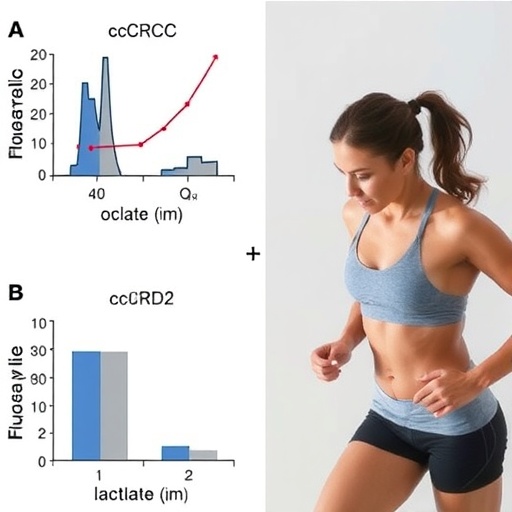In the relentless pursuit of understanding how lifestyle factors intertwine with cancer biology, a groundbreaking study published in Cell Death Discovery unveils a compelling molecular mechanism by which exercise can directly suppress clear cell renal cell carcinoma (ccRCC), one of the most aggressive and common forms of kidney cancer. The research, led by Miao, R., Liu, C., Wang, Y., and colleagues, elucidates how lactate—a metabolic byproduct traditionally viewed merely as a marker of cellular activity—plays an active role in tumor suppression through a novel pathway involving CNDP2 and intracellular amino acid depletion.
For decades, the beneficial influence of regular physical activity on cancer incidence and progression has been recognized epidemiologically, yet the precise biochemical underpinnings remain shrouded in complexity. This study sheds light on a pivotal link between exercise-induced metabolic changes and tumor cell vulnerability, suggesting that lactate accumulation from muscle activity is not just a metabolic waste but an intricate signaling molecule capable of rewiring tumor metabolism at the cellular level.
Clear cell renal cell carcinoma, characterized by its notorious resistance to conventional therapies, represents a critical challenge in oncology. Its pathogenesis involves profound metabolic reprogramming, with tumor cells adapting to hypoxic conditions and altered nutrient availability—factors that drive unchecked proliferation and metastasis. Previous research has hinted at metabolic dependencies in ccRCC, but this new work advances the field by identifying a tangible connection between exercise-induced systemic factors and tumor intracellular metabolism.
.adsslot_q3ds9IZaOK{ width:728px !important; height:90px !important; }
@media (max-width:1199px) { .adsslot_q3ds9IZaOK{ width:468px !important; height:60px !important; } }
@media (max-width:767px) { .adsslot_q3ds9IZaOK{ width:320px !important; height:50px !important; } }
ADVERTISEMENT
Central to this discovery is the enzyme CNDP2, a dipeptidase that emerged as a crucial mediator in the metabolic crosstalk triggered by lactate exposure. The scientists demonstrated that lactate accumulation upregulates CNDP2 expression within ccRCC cells, which in turn catalyzes the breakdown of specific dipeptides, leading to a consequential depletion of intracellular amino acids. This amino acid scarcity disrupts critical biosynthetic and energy-generating pathways, essentially starving tumor cells and curbing their proliferation capacity.
The team employed a comprehensive array of experimental techniques, including in vitro tumor cell models, murine exercise regimens, and metabolomic profiling, to decode this intricate cascade. Their multifaceted approach confirmed that lactate derived from muscle activity elevates CNDP2 at both the mRNA and protein levels, and that this modification drastically alters the amino acid landscape inside cancer cells. Strikingly, this metabolic disruption renders ccRCC cells more susceptible to apoptosis and growth arrest.
In exploring the broader implications of their findings, the researchers also noted that the metabolic interference caused by CNDP2-mediated amino acid depletion intersects with key oncogenic signaling networks. Pathways such as mTOR and AMPK, known master regulators of cell growth and metabolism, appear affected by changes in amino acid availability, suggesting that exercise-generated lactate influences tumor biology through multi-layered regulatory nodes. This insight uncovers potential combinatorial strategies for adjunct therapies alongside physical exercise interventions.
This revelation invites a reevaluation of metabolic therapies aimed at cancer. Rather than universally targeting lactate production or signaling, nuanced strategies could leverage controlled exercise regimens to exploit this natural metabolic vulnerability of ccRCC cells. The prospect of integrating aerobic exercise-based metabolic modulation with pharmacological agents targeting CNDP2 or amino acid metabolism signals a promising horizon for personalized oncology.
Translational aspects of this research are equally compelling. From a clinical standpoint, these insights justify the incorporation of structured exercise programs into therapeutic protocols for ccRCC patients and possibly beyond. Tailoring exercise prescriptions to optimize lactate production and CNDP2 activation may not only improve patient outcomes by directly curtailing tumor growth but also enhance overall well-being through well-established systemic benefits.
Importantly, the study also highlights the sophisticated interplay between tumor microenvironment and systemic metabolism. Exercise-induced lactate circulates in the bloodstream, affecting not only local muscle tissue but distant organs, including tumors. Hence, the tumor microenvironment must be understood in a systemic context, where metabolic cues from physical activity orchestrate cellular processes that either fuel or frustrate malignancy.
The research narrative delves into cellular energetics, showing that intracellular amino acid depletion caused by CNDP2 impairs protein synthesis, redox balance, and nucleotide turnover—a triad integral to cancer cell survival. By undermining these biosynthetic pathways, CNDP2 effectively compromises cellular resilience, pushing ccRCC cells toward metabolic crisis. This mechanistic depth enriches our comprehension of how subtle shifts in nutrient flux can precipitate profound effects on tumor fate.
Further strengthening their conclusions, the investigators confirmed the presence of CNDP2-mediated effects in patient-derived ccRCC tissues, suggesting clinical relevance beyond experimental models. This translational validation offers a feasible biomarker for gauging tumor responsiveness to exercise-linked metabolic interventions and possibly stratifying patients for targeted therapeutic combinations.
The discovery also spurs questions about the specificity of this mechanism. Does CNDP2-driven intracellular amino acid depletion apply uniquely to ccRCC, or might it exert influence across other tumor types with similar metabolic phenotypes? Given the heterogeneity of tumor metabolism, future research into CNDP2’s role in broader oncological contexts could reveal new therapeutic avenues or unforeseen resistance mechanisms.
Taken together, this pioneering study eloquently intertwines disciplines of exercise physiology, metabolism, and oncology, igniting a paradigm shift that reframes how we perceive the interface of lifestyle and cancer biology. It underscores the profound impact of metabolic modulation through endogenous molecules like lactate, advocating a more integrative approach to cancer treatment that harmonizes patient lifestyle, molecular biology, and therapeutic innovation.
In an era where personalized medicine is rapidly advancing, such revelations emphasize the necessity to consider physical activity not merely as a supportive element but as a potent biological modifier capable of reconfiguring tumor cell fate. The strategic harnessing of exercise-induced metabolic shifts offers an inspiring blueprint for future research and clinical translation in the fight against ccRCC and potentially other stubborn malignancies.
As the scientific community continues to unravel the complex metabolic tapestries that sustain cancer, findings like these serve as a beacon illuminating the untapped potential lying within our own physiology. Exercise, often touted for its holistic health benefits, emerges here as a formidable biochemical weapon, wielded through the metabolic enzyme CNDP2 and its consequential reshaping of the tumor intracellular environment. This research invites a fresh and hopeful perspective—that the cure to some cancers might lie, at least in part, in the cadence of our own breath and the rhythm of our movement.
Subject of Research: The molecular mechanisms by which exercise-induced lactate suppresses clear cell renal cell carcinoma (ccRCC) through CNDP2-mediated depletion of intracellular amino acids.
Article Title: Exercise-induced lactate suppresses ccRCC via CNDP2-mediated depletion of intracellular amino acids.
Article References:
Miao, R., Liu, C., Wang, Y. et al. Exercise-induced lactate suppresses ccRCC via CNDP2-mediated depletion of intracellular amino acids. Cell Death Discov. 11, 356 (2025). https://doi.org/10.1038/s41420-025-02609-3
Image Credits: AI Generated
DOI: https://doi.org/10.1038/s41420-025-02609-3
Tags: biochemical pathways in ccRCCclear cell renal cell carcinomaCNDP2 and cancer metabolismexercise and cancer biologyexercise-induced metabolic changesintracellular amino acid depletionlactate role in tumor suppressionmetabolic byproducts in oncologyphysical activity and kidney cancerrenal cell carcinoma resistance to therapysignaling molecules in cancer treatmenttumor cell vulnerability mechanisms





